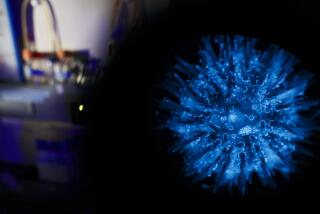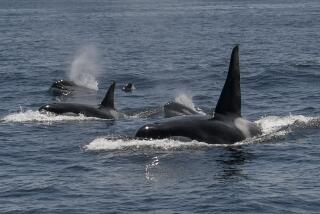Mapping an ocean of life forms on the move
- Share via
WOODS HOLE, MASS. — The first comprehensive effort to identify and catalog every species in the world’s oceans, from microbes to blue whales, is a year from completion. But early discoveries have profoundly altered understanding of life beneath the sea, senior scientists say.
New tracking tools, for example, show that some bluefin tuna migrate between Los Angeles and Yokohama, Japan; one tagged tuna crossed the Pacific three times in a year. White sharks forage even farther for food, commuting between Australia and South Africa.
Some turtles circumnavigate the Pacific, paddling from Baja to Borneo. And a gray-headed albatross -- a member of the world’s most threatened family of birds -- stunned researchers when it raced around the globe in 46 days flat.
“The extent of movement and migration is way beyond what anyone had . . . even contemplated,” said environmental scientist Jesse Ausubel, a co-founder of the Census of Marine Life. “What we’re learning is fundamentally different from what we knew before.”
Since the $650-million, decade-long project began in May 2000, researchers have used deep-sea robots, laser-based radar and super-sensitive sonar that can track fish 90 miles away.
Census teams also embarked on about 400 shipboard expeditions. They discovered life forms faster than they could verify and name -- more than 5,600 suspected new species so far, many from the hottest, coldest, saltiest and deepest parts of the oceans.
They also found a very old species, a shrimp that textbooks said had been extinct for 50 million years. The five-inch specimen, with big eyes and red spots, was found swimming a mile beneath the ocean off northeast Australia.
“It recalls the time, hundreds of years ago, when science really was about voyages of discovery,” said Laurence Madin, director of research at the Woods Hole Oceanographic Institution, the world’s largest private, nonprofit center for marine science.
Nine years of field study -- on tropical reefs and under polar caps, on the sea floor and in the surf -- has led to sharp reappraisals of how the world works and how it is changing. Some scientists compare the search for biodiversity to the successful effort to map the human genome.
“We’re taking stock for the first time on what lives in the ocean,” said Poul Holm, a marine historian at Trinity College Dublin in Ireland. “That is of fundamental importance to life on Earth and to human existence.”
Among the findings: The abyssal plains, the inky-black, featureless ocean floor that covers more than half the planet, are not barren, lifeless deserts.
The proof came when scientists used fine-mesh sieves to trawl nearly three miles down. To their surprise, they scooped up tens of thousands of swimming snails, worms and other tiny invertebrates in almost every net. Many had never been seen before.
“Probably the greatest diversity of life is in the deep sea,” said Fred Grassle, director emeritus at the Institute of Marine and Coastal Sciences at Rutgers University in New Jersey. “We’re just beginning to learn about it.”
The census, which will be released in October 2010, is cataloging even the smallest of organisms, such as bacteria and the single-celled microorganisms called archaea. Scientists suspect they play a role in the carbon and nitrogen cycles, which are crucial to sustaining life.
“We have clearly grossly underestimated the microbial diversity in the oceans,” said Paul Snelgrove, an oceanographer from Memorial University of Newfoundland in Canada. “And that’s enormously important. Those microbes do a lot of the things that keep the Earth humming along.”
On the opposite end of the spectrum, researchers found huge scaly worms, manhole-sized starfish and sea spiders as big as dinner plates during expeditions to the frigid, swirling seas of the Antarctic, where the underwater carousel acts as a kind of incubator for new species.
In addition, forensic historians working on the census examined ancient Greek texts, pre-Incan pottery and even 100 years’ worth of restaurant menus archived at the New York City Public Library in hopes of documenting man’s impact on the world’s oceans.
In Europe, they found Renaissance-era paintings of fish markets with seafood that no longer exists in local waters. In North America, customs records and captains’ logbooks indicated that fishermen in the Gulf of Maine hooked 20 times more cod in 1860 than commercial fleets do today.
The bottom line: Overfishing has drastically reduced some fish populations. And many species are smaller in size than just a few decades ago.
“What we’re seeing is the loss of productivity is almost everywhere, not just in a few places,” said Andrew Rosenberg, a professor at the University of New Hampshire. “We’ve never had this kind of data.”
Ausubel and Grassle hatched the idea of surveying every species in the sea while working from a ramshackle office at the Woods Hole institute in July 1996. “Almost everyone said it was crazy,” said Ausubel, a senior research associate at Rockefeller University in New York.
Ignoring the skeptics, Ausubel persuaded the Alfred P. Sloan Foundation to provide funding. Governments and other foundations later chipped in.
The scientists set three goals. First, they would build a global registry of every marine life form, worms to walruses, as a baseline for research and public policy. Second, they would map where each species lives and travels to better understand its habitat. Lastly, they would assess the relative abundance of each organism -- past, present and future.
Most marine biologists are specialists who work alone or in small groups. The census has changed that. About 2,000 scientists in 80 countries have joined forces in the largest collaboration in the history of ocean science.
“This was a field in need of a revolution,” said Ann Bucklin, who heads the marine sciences department at the University of Connecticut. “It has opened up global oceanography.”
Scientists have embraced the effort to compile a “bar code of life” that uses DNA sequencing to identify each marine species. Until now, eyeballing a crab, coral or cod was the only way to identify it. Tiny zooplankton were even tougher.
“In the past, I have spent hours and hours at the microscope looking at spines or legs or other minutiae to tell species A from species B,” said Nancy Copley, a Woods Hole researcher. “Sometimes it was very hard to tell.”
By next year, the online database will contain photos, DNA codes and websites for at least 230,000 unique species, including more than 16,000 fish, scientists said.
“It’s going to be the Rosetta Stone for the future,” said Peter Wiebe, a senior biologist at Woods Hole. “Once we know what’s out there, we can build on it.”
The list would be longer, but researchers used DNA analysis to cut more than 50,000 “aliases” -- different names for the same creature -- from the species list. The worst case of multiple identity was a breadcrumb sponge, Halichondria panacea, which had 56 names around the world. Now it will have one.
Though the science is crucial, said Ausubel, “in the end the beauty of the ocean is what inspires us.”
“Sometimes I think it was a terrible mistake to crawl out onto the land.”
--







